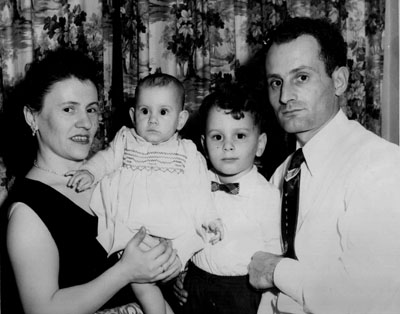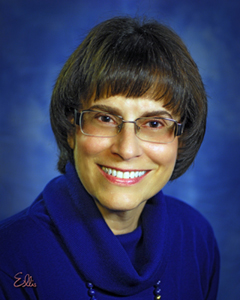The Next Generation

 By Esther Toporek Finder
By Esther Toporek Finder
The USC Shoah Foundation’s Visual History Archive is a resource of tremendous depth and scope, wherein the firsthand accounts of the survivors and witnesses allow us to gaze into the bottomless evil that was the Holocaust. Conversely, we can also appreciate, through their testimonies, the strength of the human spirit. Generations to come will be able not only to hear the authentic voices of those who were there but also see the emotions in the facial expressions of these remarkable people and meet their families.
As the daughter of two Auschwitz-Birkenau survivors, the value of first-person narratives is close to me. My mother died in 1970 at the age of 47. At that time, families did not have the technology to save oral histories that we have today. I was young and could not have realized that the window of opportunity to preserve her story was so limited. All I have of my mother’s history are some anecdotal pieces. I do not even have her voice recorded. One of the reasons I volunteered and worked so diligently to interview as many people as I could with the Shoah Foundation was so other families could preserve not only the story but also the voice of their beloved parents.
My father’s testimony is recorded, and for our family this is a gift. Prisoner 145183 will be known to future generations by his name, Harry Toporek, not by the number on his arm. We have a permanent record captured when he was in sound health. He is no longer capable of doing an interview so I truly appreciate that Steven Spielberg did make it possible to preserve his precious legacy in a timely way.
As well as being a child of survivors, in my professional life I am an educator and I know you cannot reach students if they do not see the relevance of the subject. That is why it is crucial that lessons of the Shoah resonate with students today and in the future. This is not just history, nor is it about our generation only. Its implications reach into how we live now and will for generations to come. For this to be effective, the Holocaust can and should be taught in multiple disciplines. The Visual History Archive can help students see what happens under a repressive dictatorship when there is no balance of power and no freedom of the press or personal expression. There are reasons why free countries have separate executive, legislative, and judiciary branches of government. What better way to teach students about the rights, freedoms, and responsibilities of living in a democracy than to contrast democratic values with those of the Nazis?
The Holocaust has profound and particular power for those of us who grew up in its shadow, but that is where its particularity ends. As much as it affects us as Jews, it is not a Jewish story; it is a human experience. When I teach psychology classes, concepts like prejudice and discrimination are intricately linked. I also use the Shoah to demonstrate the power of the situation, conformity, obedience, group think, diffusion of responsibility, de-individuation, and more. That was true of people in the 1940s will be true for us in 2040 and beyond. What may improve is how we understand and deal with our human frailties.
As part of a technologically connected second-generation community we appreciate the advances made by the USC Shoah Foundation, which have made it possible for students around the world to have a dynamic and personal relationship with the survivors. I was particularly delighted to see one of the interviews I had conducted featured in the award-winning student film “Beanstar.” This short film, a true story of a young woman who, as a Mexican, personally experienced stereotyping and discrimination, is a perfect example of how survivor testimony can resonate with students today.
 The Toporek family in Chicago 1953
The Toporek family in Chicago 1953At times, life is more dramatic than fiction or any Hollywood script. During his training, the refugee-turned-spy I interviewed was specifically told not to impersonate a German soldier, so he did not: He impersonated a German officer. He collected intelligence on transports of men and materiel through the Brenner Pass. Because he relayed that information to Allied command, they were able to destroy dozens of military trains, thus shortening the war in Europe. How many more people—prisoners, soldiers on both sides, and civilians—would have died without one man’s intervention?
Therein lies the secret of the Visual History Archive. Each story is individual and carries its own weight and complexity. I was moved when a child survivor told me of his education during World War II. The very thought of educating children in his ghetto, which was an offense that carried a death sentence, was an act of resistance and bravery as well as an act of hope. Hearing this made me appreciate our thirst for knowledge and the tenacity of the human spirit. It is that which drives me to teach and to tell this story, as there is much to learn from those who gave their testimony. I was privileged to interview a Polish survivor who hid with her infant son in a residence run by Catholics. While there, she was asked to provide breast milk for an orphaned baby girl—a Jewish woman hiding in a monastery saving the life of a Christian child.
Children and grandchildren of survivors have started to use their loved one’s testimony in their own public presentations in schools. That multi-generational perspective on the Holocaust and its lasting legacy provides momentum and relevance as never before. These testimonies will live beyond us and touch the future.
Twenty years after its founding, my heartfelt thanks to Steven Spielberg, who made it possible for my father to tell his story, for me to be touched by so many lives, and proud, as a part of the second generation, to be a part of something that will be there for many generations to come.
(The 2011 Student Voices film Beanstar, by Mariana Aguilar, features testimony conducted by Finder)
Like this article? Get our e-newsletter.
Be the first to learn about new articles and personal stories like the one you've just read.